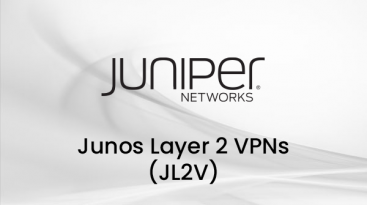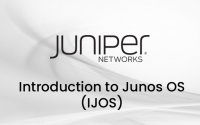Overview
This course is designed to provide students with MPLS-based Layer 2 virtual private network (VPN) knowledge and configuration examples. The course includes an overview of MPLS Layer 2 VPN concepts, such as BGP Layer 2 VPNs, LDP Layer 2 circuits, FEC 129 BGP autodiscovery, virtual private LAN service (VPLS), Ethernet VPN (EVPN), and Inter-AS Layer 2 VPNs.
Duration 2 days.
You can find current trainings on training calendar page.
Training Prerequisites
Students should have intermediate-level networking knowledge and an understanding of OSPF, IS-IS, BGP, and Junos policy. Students should have experience configuring MPLS label-switched paths using Junos. Students should also attend Introduction to the Junos Operating System (IJOS),Junos Service Provider Switching (JSPX), Junos Intermediate Routing (JIR) and Junos MPLS Fundamentals (JMF) courses prior to attending this class.
Training Contents
Course Introduction
MPLS VPNs
- MPLS VPNs
- Provider-Provisioned VPNs
BGP Layer 2 VPNs
- Overview of Layer 2 ProviderProvisioned VPNs
- BGP Layer 2 VPN Operational Model:Control Plane
- BGP Layer 2 VPN Operational Model:Data Plane
- Preliminary BGP Layer 2 VPN Configuration
- BGP Layer 2 Configuration
- Monitoring and Troubleshooting BGP Layer 2 VPNs
Layer 2 VPN Scaling and CoS
- Review of VPN Scaling Mechanisms
- Layer 2 VPNs and CoS
LDP Layer 2 Circuits
- LDP Layer 2 Circuit Operation
- LDP Layer 2 Circuit Configuration
- LDP Layer 2 Circuit Monitoring and Troubleshooting
- FEC 129 BGP Autodiscovery Layer 2 Circuit Operation
- FEC 129 BGP Autodiscovery Layer 2 Circuit Configuration
- FEC 129 BGP Autodiscovery Monitoring and Troubleshooting
Virtual Private LAN Services
- Layer 2 MPLS VPNs Versus VPLS
- BGP VPLS Control Plane
- BGP VPLS Data Plane
- Learning and Forwarding Process
- Loops
VPLS Configuration
- VPLS Configuration
- VPLS Troubleshooting
Ethernet VPN (EVPN)
- EVPN Overview
- EVPN Control Plane
- EVPN Operation
- EVPN Configuration
- EVPN Troubleshooting
Training Objectives
- Define the term virtual private network.
- Describe the business drivers for MPLS VPNs.
- Describe the differences between Layer 2 VPNs and Layer 3 VPNs.
- List advantages for the use of MPLS Layer 3 VPNs and Layer 2 VPNs.
- Describe the roles of a CE device, PE router, and P router in a BGP Layer 2 VPN.
- Explain the flow of control traffic and data traffic for a BGP Layer 2 VPN.
- Configure a BGP Layer 2 VPN and describe the benefits and requirements of over-provisioning.
- Monitor and troubleshoot a BGP Layer 2 VPN.
- Explain the BGP Layer 2 VPN scaling mechanisms and route reflection.
- Describe the Junos OS BGP Layer 2 VPN CoS support.
- Describe the flow of control and data traffic for an LDP Layer 2 circuit.
- Configure an LDP Layer 2 circuit.
- Monitor and troubleshoot an LDP Layer 2 circuit.
- Describe the operation of FEC 129 BGP autodiscovery for Layer 2 VPNs.
- Configure a FEC 129 BGP autodiscovery Layer 2 VPN.
- Monitor and troubleshoot a FEC 129 BGP autodiscovery for Layer 2 VPNs.
- Describe the difference between Layer 2 MPLS VPNs and VPLS.
- Explain the purpose of the PE device, the CE device, and the P device.
- Explain the provisioning of CE and PE routers.
- Describe the signaling process of VPLS.
- Describe the learning and forwarding process of VPLS.
- Describe the potential loops in a VPLS environment.
- Configure BGP, LDP, and FEC 129 BGP autodiscovery VPLS.
- Troubleshoot VPLS.
- Describe the purpose and features of Ethernet VPN.
- Configure Ethernet VPN.
- Monitor and troubleshoot Ethernet VPN.
- Describe the Junos OS support for hierarchical VPN models.
- Describe the Junos OS support for Carrier-of-Carriers VPN Option C.
- Configure the interprovider VPN Option C.
- Describe the Junos OS support for multisegment pseudowire for FEC 129.
- Describe and configure circuit cross-connect (CCC).
Who should attend?
This course benefits individuals responsible for configuring and monitoring devices running the Junos OS.
- Overview
- Prerequisites
- Contents
- Objectives
- Audience
Overview
This course is designed to provide students with MPLS-based Layer 2 virtual private network (VPN) knowledge and configuration examples. The course includes an overview of MPLS Layer 2 VPN concepts, such as BGP Layer 2 VPNs, LDP Layer 2 circuits, FEC 129 BGP autodiscovery, virtual private LAN service (VPLS), Ethernet VPN (EVPN), and Inter-AS Layer 2 VPNs.
Duration 2 days.
You can find current trainings on training calendar page.
Training Prerequisites
Students should have intermediate-level networking knowledge and an understanding of OSPF, IS-IS, BGP, and Junos policy. Students should have experience configuring MPLS label-switched paths using Junos. Students should also attend Introduction to the Junos Operating System (IJOS),Junos Service Provider Switching (JSPX), Junos Intermediate Routing (JIR) and Junos MPLS Fundamentals (JMF) courses prior to attending this class.
Training Contents
Course Introduction
MPLS VPNs
- MPLS VPNs
- Provider-Provisioned VPNs
BGP Layer 2 VPNs
- Overview of Layer 2 ProviderProvisioned VPNs
- BGP Layer 2 VPN Operational Model:Control Plane
- BGP Layer 2 VPN Operational Model:Data Plane
- Preliminary BGP Layer 2 VPN Configuration
- BGP Layer 2 Configuration
- Monitoring and Troubleshooting BGP Layer 2 VPNs
Layer 2 VPN Scaling and CoS
- Review of VPN Scaling Mechanisms
- Layer 2 VPNs and CoS
LDP Layer 2 Circuits
- LDP Layer 2 Circuit Operation
- LDP Layer 2 Circuit Configuration
- LDP Layer 2 Circuit Monitoring and Troubleshooting
- FEC 129 BGP Autodiscovery Layer 2 Circuit Operation
- FEC 129 BGP Autodiscovery Layer 2 Circuit Configuration
- FEC 129 BGP Autodiscovery Monitoring and Troubleshooting
Virtual Private LAN Services
- Layer 2 MPLS VPNs Versus VPLS
- BGP VPLS Control Plane
- BGP VPLS Data Plane
- Learning and Forwarding Process
- Loops
VPLS Configuration
- VPLS Configuration
- VPLS Troubleshooting
Ethernet VPN (EVPN)
- EVPN Overview
- EVPN Control Plane
- EVPN Operation
- EVPN Configuration
- EVPN Troubleshooting
Training Objectives
- Define the term virtual private network.
- Describe the business drivers for MPLS VPNs.
- Describe the differences between Layer 2 VPNs and Layer 3 VPNs.
- List advantages for the use of MPLS Layer 3 VPNs and Layer 2 VPNs.
- Describe the roles of a CE device, PE router, and P router in a BGP Layer 2 VPN.
- Explain the flow of control traffic and data traffic for a BGP Layer 2 VPN.
- Configure a BGP Layer 2 VPN and describe the benefits and requirements of over-provisioning.
- Monitor and troubleshoot a BGP Layer 2 VPN.
- Explain the BGP Layer 2 VPN scaling mechanisms and route reflection.
- Describe the Junos OS BGP Layer 2 VPN CoS support.
- Describe the flow of control and data traffic for an LDP Layer 2 circuit.
- Configure an LDP Layer 2 circuit.
- Monitor and troubleshoot an LDP Layer 2 circuit.
- Describe the operation of FEC 129 BGP autodiscovery for Layer 2 VPNs.
- Configure a FEC 129 BGP autodiscovery Layer 2 VPN.
- Monitor and troubleshoot a FEC 129 BGP autodiscovery for Layer 2 VPNs.
- Describe the difference between Layer 2 MPLS VPNs and VPLS.
- Explain the purpose of the PE device, the CE device, and the P device.
- Explain the provisioning of CE and PE routers.
- Describe the signaling process of VPLS.
- Describe the learning and forwarding process of VPLS.
- Describe the potential loops in a VPLS environment.
- Configure BGP, LDP, and FEC 129 BGP autodiscovery VPLS.
- Troubleshoot VPLS.
- Describe the purpose and features of Ethernet VPN.
- Configure Ethernet VPN.
- Monitor and troubleshoot Ethernet VPN.
- Describe the Junos OS support for hierarchical VPN models.
- Describe the Junos OS support for Carrier-of-Carriers VPN Option C.
- Configure the interprovider VPN Option C.
- Describe the Junos OS support for multisegment pseudowire for FEC 129.
- Describe and configure circuit cross-connect (CCC).
Who should attend?
This course benefits individuals responsible for configuring and monitoring devices running the Junos OS.






